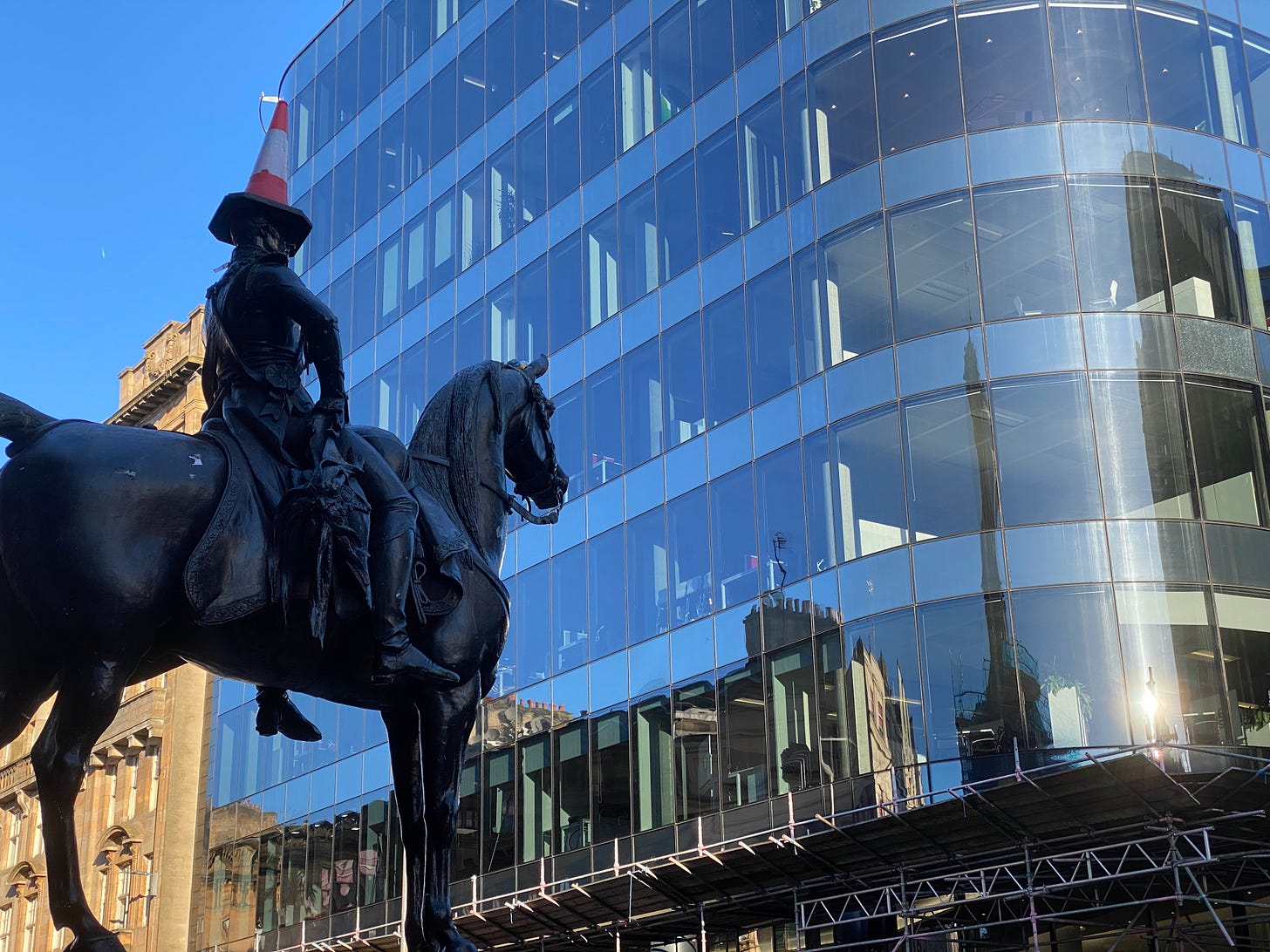Robinson and The Problem of Glasgow
A video essay
This week’s newsletter is a double experiment. The first experiment is a 6-minute video essay inspired by the work of Patrick Keiller. The second is a collaboration with Alfie Robinson in the form of a dialogue on the same topic.
Video Transcript:
For a long time now I have been thinking about the problem of Glasgow. It is a city in perpetual crisis, suffering the worst ill-health in Europe. It is a dirty city, where littering is rampant and almost every surface is covered in graffiti. Its historic buildings are either falling apart or mysteriously burning down. It is a city that has lost its way.
When I heard that Robinson, a young urbanist, was going to be in Glasgow, I wondered if he would like to do a psychogeographical dérive in the city. Perhaps Robinson, with his outsider's view, could help solve the problem of Glasgow.
We arranged to meet by the Wellington statue, the defining symbol of modern Glasgow. The Duke of Wellington, the nemesis of Napoleon, enabled the British Empire to dominate the world in the nineteenth century. As a port city dealing in transatlantic trade, Glasgow flourished as the second city of the empire.
Nowadays the statue is best known for wearing a cone. What a comedown. The cone, frequently replaced, is Banksy's favourite work of art because it shows the irreverence and defiance of the Glaswegians. But it is a joke on the past. It doesn't offer anything to the future. It doesn't build the new.
Robinson hadn't eaten lunch and was too hungry to solve the problem of Glasgow, so we went back to my flat where he could prepare the pickled herring he had brought from Germany.
Close to my flat, coincidentally, is The Briggait, the city's former fish market. The Hippocamps that adorn the building are one of the few reminders of its former use.
On Glasgow Green, we see the McLellan Arch, which I mistakenly believed to be a monument to a temperance campaigner. Robinson was in Glasgow for a whisky festival, so I felt it my duty to warn him of the dangers of drink.
As well as a statue of Wellington, Napoleon's other great foe, Horatio Nelson, is celebrated with an obelisk in the middle of the green. It is off-centre, giving it a three-dimensional quality.
"I prefer that obelisk," said Robinson, pointing to the chimney of the whisky factory across the river in the Gorbals.
We approached the sadly neglected Winter Gardens. The story I heard is that one shard of glass fell and then the whole building was condemned. It is a great loss for lovers of plants. On the other side is the People's Palace, a social history museum about Glasgow, where pilgrims gather from around the world to see Billy Connolly's banana boots.
On the east side of the park is the Templeton Carpet Factory, a Victorian recreation of the Doge's Palace in Venice. Robinson is impressed, although slightly less so when I mention that The Cultural Tutor had recently posted about it.
During the Black Lives Matter protests of 2020, a great number of statues were toppled and I was sure that the fragile terracotta of the Doulton Fountain would be damaged. It is, after all, a monument to colonialism with Queen Victoria presiding over soldiers who stand on top of subject populations around the world.
Is the problem of Glasgow its toxic history, its hundred years of bad karma? In nearby Calton, the life expectancy for men has been as low as 54, worse than any warzone. But investment in the nearby Barras market has left the area looking clean and welcoming.
We are in historic Glasgow. Near the pub where Boswell and Johnson stopped on their tour of Scotland, heading towards the High Street, the former heart of the city with its recreation Mercat cross and old clock tower.
The factory smoke and the squalor of the Industrial Revolution pushed the middle classes out West, leaving the Cathedral marooned. In the necropolis, the revolutionary protestant John Knox commands a view over the city.
Robinson and I arranged to meet Peter, a philosopher friend, who had finished work for the day. We headed to Sauchiehall Street which is a grim sight as the department stores closed one by one. Solving the problem of Glasgow means solving the problem of what to do with high streets when people buy everything online.
We visit the sad shell of the Glasgow School of Art. The first fire at the art school was caused by contemporary art. The second remains undetermined, but it is sad to see the building wrapped in plastic, looking ready to be popped
We head West, down towards the flyover crossing a dozen or so lanes of traffic. How can we solve the problem of Glasgow when faced with this monstrosity? "Three words, said Robinson, replace the M8."
It's true, it is a scar on the city. Ugly, noisy, polluting, and dividing it in two. But what's worse, I think, is that it encourages people to move out of the city, safe in the knowledge that there is a quick and convenient route for suburbanites to come and go without actually contributing to the tax base. To improve health, to reduce alienation, for the vitality of the city, the M8 has to go.









Very clever Neil! I hope everyone gets the Patrick Keiller reference - if not, they should watch this: https://www.youtube.com/watch?v=nTGH3G8YkaU
I've been to Glasgow twice, some ancestors came from here, though not long enough or official enough to be recorded there> Te Glass sisters are my main genealogical 'brickwall'. Anyways, in Glasgow ① I discovered it was extra to spin clothes at the laundrette, and ② I discovered most Australians were, like myself, travelling on their Euro passports. Also now a bygone era.